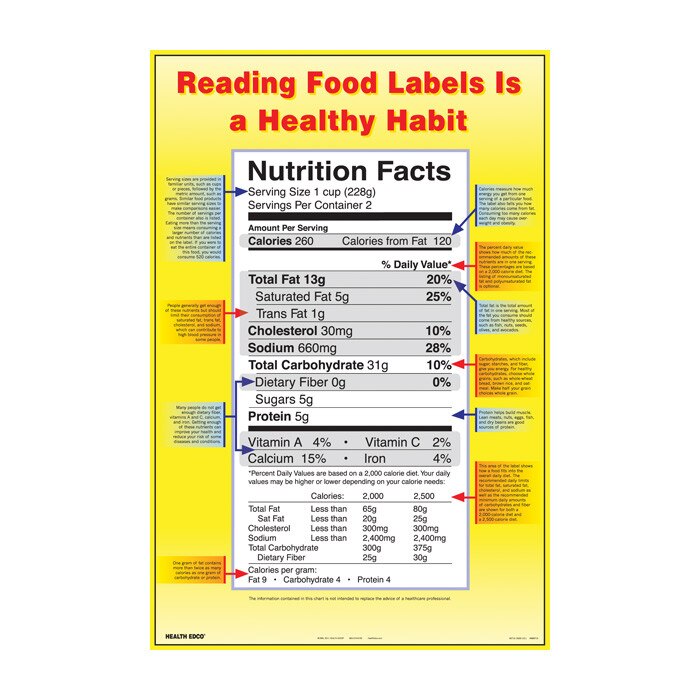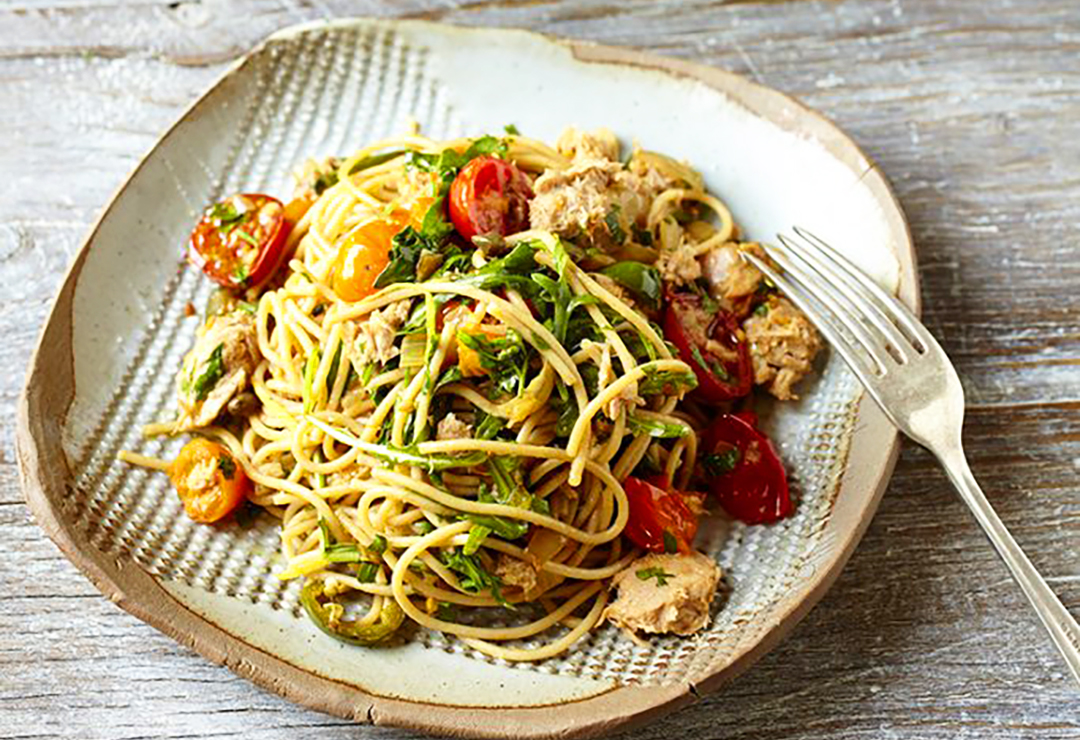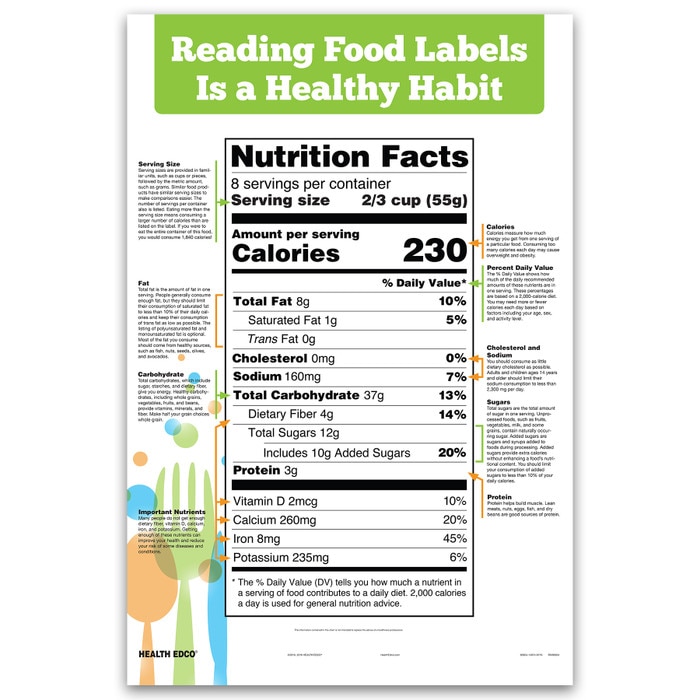41 reading food labels diabetes
Reading food labels: Tips if you have diabetes - Mayo Clinic Food labels can be an essential tool for diabetes meal planning. Here's what to look for when comparing food labels. By Mayo Clinic Staff When you live with diabetes, your diet is a vital part of your treatment plan. Of course, you know what you're eating — a turkey sandwich, a glass of skim milk, a sugar-free fudge pop. PDF What Can I eat? - American Diabetes Association list of everything that is in the food. They are listed by the highest amount to the least. If the first word in the list is sugar, then there is more sugar in the food than anything else. Reading Food Labels Food labels can help you choose what foods to eat. Use the labels at right to find the best choice. 1-800-DIABETES (1-800-342-2383) www ...
PDF TO CARE 4 YOURSELF READING A NUTRITION FACTS LABEL - novoMEDLINK Reading the label can help you compare the amount of sodium in different foods so that you can choose lower-sodium options. Talk with your diabetes care team about what to include in your meal plan. Reading a Nutrition Facts label Reference: 1. American Diabetes Association. Standards of medical care in diabetes—2019.

Reading food labels diabetes
Reading food labels & nutrition panel - Diabetes Queensland Reading food labels When choosing packaged food, choose products with: lower energy (kilojoules) if you are trying to lose weight lower total and saturated fat lower sugar lower sodium higher fibre Every food label tells a story and the Nutrition Information Panel simply gives you the facts. Understanding food labels | Diabetes UK Check the ingredients list - if syrup, invert syrup, cane sugar, molasses or anything ending in 'ose' is within the first three ingredients, this suggests the food contains more added sugar. Choose an alternative if possible, or be mindful of the portion you eat. Check the fibre content on the back of pack label. How to Read Food Labels When You Are Diabetic - Diabetics Weekly Study the Carbohydrate Content in Detail. This is the most important aspect of how to read food labels when you have diabetes. The total amount of carbohydrates breaks down into complex carbohydrates, sugar, and fiber. Don't hone in on zero-sugar foods, as foods like milk and fruit contain natural sugars. By the same token, make sure to watch ...
Reading food labels diabetes. How to Read Food Labels When You Have Type 2 Diabetes Quick Tip: When you see sugar-free on a label it means less than 0.5 grams of sugar per serving. No sugar added doesn't mean low or no-carb. A lot of food labels say "no sugar added" but these foods might have tons of carbs. No sugar added simply means no sugar was added during processing or packaging. Sugar alcohols have hidden carbs. Making Sense of Food Labels | ADA - diabetes.org Reading labels can help you find these hidden sources and compare the sodium in different foods. Whether you have diabetes or not, 2300 milligrams (mg) or less per day is the general recommendation. If you have high blood pressure, talk with your health care team to find out the best goal for you. List of ingredients Reading Food Labels When You Have Diabetes | Cigna Start with the "% Daily Value" column on the food label. A food is considered low in a specific nutrient (such as fat, saturated fat, carbohydrate, or sodium) if it has 5% or less of the daily value. A food is considered high in that nutrient if it has 20% or more of the daily value. Watch out for health claims on food labels. Reading Food Labels, The Most Basic Tool in Diabetes Management Reading food labels for people with diabetes is an important tool in the management of the disease. Our skilled nurses help you to better understand the Nutrition Facts labels. (702) 871-9917
PDF Label reading basics for diabetes - Veterans Affairs Label Reading Basics for Diabetes Nutrition and Food Services (05/2020) Serving Size • The serving size is the portion size used for all the values on the label. • Different foods have different serving sizes. • The serving size on this label is 2/3 cup. Servings per Container • Indicates the number of Learning To Read Labels :: Diabetes Education Online On a nutrition food label, subtract the fiber from the total carbohydrate amount. When you read food labels, the grams of sugar are already included in the total carbohydrate amount, so you do not need to count this sugar amount separately. The grams of sugar listed include both natural sugars, from fruit or milk, and added sugars. How to Read the New Food Label All food products should have the new label by January 2021. It's essential for people with diabetes to read labels and understand what's in the food you eat. The Nutrition Facts label gives you information to compare products and decide what's right for you. When reading the Nutrition Facts label, start at the top with information about servings. Reading Food Labels to manage Diabetes When reading food labels, it is important to understand the difference between simple and complex sugars, as their effect on blood glucose levels is not the same: Simple, or "fast", sugars have a high glycaemic index and will therefore be rapidly digested, which can cause hyperglycaemia.
Reading Food Labels | ADA Reading labels can help you find these hidden sources and compare the sodium in different foods. Whether you have diabetes or not, 2300 milligrams (mg) or less per day is the general recommendation. If you have high blood pressure, talk with your health care team to find out the best goal for you. List of ingredients Reading food labels: Tips if you have diabetes - Drugs.com Nutrients and Daily Value: The label must list the amounts of total fat, saturated fat, trans fat, cholesterol, sodium, total carbohydrate, dietary fiber, sugars, protein, vitamin D, calcium, iron and potassium that are in one serving. The Daily Value (DV) tells you how close you are to meeting your daily requirements for each nutrient. Diabetes Food Label Reading: Quick Tips to Shop Smarter In fact, you comb the rows of canned, boxed, and packaged foods to find that almost every label claims that the food is "all natural," "low in sugar," "sugar free" or "fat free." But what does this actually mean? Let's debunk some of the most common health claims made on food packaging: "Sugar free" Decoding Diabetes: How to Read Nutrition Labels | Accu-Chek The calories in the foods you eat are made up of fat, protein, and carbohydrates. Nutrition labels are typically made based on the assumption that you have a daily diet of 2,000 calories (kilocalories). Some labels will have a footnote that expand on this concept, providing numbers for both 2,000 and 2,500-calorie (kilocalorie) diets. Nutrients.
Food Labels | CDC If you eat the whole thing, you are eating 8 times the amount of calories, carbs, fat, etc., shown on the label. Total Carbohydrate shows you types of carbs in the food, including sugar and fiber. Choose foods with more fiber, vitamins, and minerals. Choose foods with lower calories, saturated fat, sodium, and added sugars. Avoid trans fat.
Reading labels | Diabetes UK Key points Always look at the 'total carbohydrate' on the label when carb counting. This will make sure you are counting both the complex (starchy) and simple (sugary) carbs in your food. Both will raise your blood glucose (blood sugar) levels, and need to be matched with insulin.
Reading Food Labels When You Have Diabetes Introduction. When a food comes in a package, take a look at the Nutrition Facts label and ingredient list on the package. Start with the "% Daily Value" column on the food label. A food is considered low in a specific nutrient (such as fat, saturated fat, cholesterol, carbohydrate, or sodium) if it has 5% or less of the daily value.
Reading Food Labels When You Have Diabetes - WebMD Reading Food Labels When You Have Diabetes Medically Reviewed by Michael Dansinger, MD on May 16, 2021 In this Article Serving Size Calories and Calories From Fat Nutrients Ingredients Label Claims...
PDF Label Reading Basics for Diabetes - Veterans Affairs This food has 300 mg of sodium per ½ cup serving. It is suggested to limit salt intake to 1500 mg per day when you have diabetes. With pre-diabetes, your sodium intake should still be monitored. The goal is less than 2300 mg per day. A good first step is to not have a salt shaker at home. Total Fat The area on the label describing
Reading Food Labels When You Have Diabetes | Kaiser Permanente Start with the "% Daily Value" column on the food label. A food is considered low in a specific nutrient (such as fat, saturated fat, carbohydrate, or sodium) if it has 5% or less of the daily value. A food is considered high in that nutrient if it has 20% or more of the daily value. Watch out for health claims on food labels.
Reading Food Labels | ADA - American Diabetes Association Put food labels to work. The Nutrition Facts labels on foods are really the key to making the best choices. We'll cover the basics so that these labels make shopping easier for you. You've heard it all. From carb-free to low-carb, to whole and empty carbs, it's hard to know what it all means. Blood sugar highs and lows aren't always ...
Reading Food Labels When You Have Diabetes - MedicalRecords.com Reading Food Labels When You Have Diabetes. When a food comes in a package, take a look at the Nutrition Facts label and ingredient list on the package. Start with the "% Daily Value" column on the food label. A food is considered low in a specific nutrient (such as fat, saturated fat, carbohydrate, or sodium) if it has 5% or less of the ...




/reading-ingredients-by-pobavettagettyimages-56a307933df78cf7727b8dd3.jpg)

Post a Comment for "41 reading food labels diabetes"